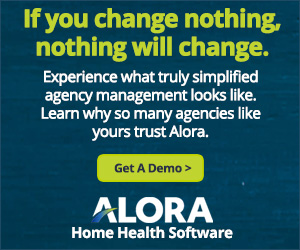
05 Jan Effective Communication and Management of Remote Home Healthcare Teams
What are the best practices for remote homecare team communications?
With home healthcare comes remote healthcare, which can be given regardless of distance. Due to the shift in dynamics over the last several years, the focus is on taking care of patients and navigating complex communication among different teams working together.
Thanks to technology, we have more accessible ways of sharing important patient information, creating a mental health support environment, and getting used to emergency situational needs. However, it’s not necessarily the technology that makes the communication effective but how these tools are implemented. So, let’s talk about the best practices for effective communication in home healthcare settings.
1. Utilize Comprehensive Communication Platforms
For home health agencies, the first step is to carefully choose communication tools that are adapted for remote healthcare teams. From integrated technology within home health software to specialized healthcare communications devices, these platforms should include different ways to talk, like video calls and messaging. There should be options for private messages, open messages, and also a meeting room for messages in real-time. They also need to have a way they can share files easily; this way, groups can make sure they have the right tools to communicate well in an online space.
Frontline workers such as nurses and caregivers greatly benefit from easy-to-use communication tools. These tools make it easier for them to talk with others on their team and share essential details about patient care. It’s the best way to keep everyone on the same page!
2. Establish Clear Communication Protocols
In addition to choosing the right communication platform, establishing a few protocols is going to be vital. Doing this gives a clear plan that doctors and nurses can follow when talking with others. In this fast-paced setting where quick answers are critical, these rules help to sort tasks based on how soon they need a reply.
Furthermore, setting different levels of importance for certain types of communication helps the team understand how serious each problem is. This way, they can use their time and resources wisely. One thing that agencies do that seems to help is create a communication guidebook. They created a color-coded table of contents and correlated those colors to tabs on the pages or chapters so that staff knew where to look. These books were left at patients’ homes; sometimes, staff would have copies. While it sounds like a lot of work to develop something like this, it’s less work than tracking and fixing errors and dealing with the fallout of severe mistakes due to communication errors.
3. Regular Virtual Check-ins and Team Meetings
Something important in the home health sector is having regular online chats and group meetings, as this will help keep the team connected. This will give team members a special place where they can come together and talk things over and update everyone on certain situations and patients. These meetings are significant for sharing patient information, talking about ongoing problems, and coming up with valuable ideas. Think of these as a staff meeting, except it’s online instead of in person.
This is a great idea as everyone will be included, and they don’t need to carve out time for traveling to a staff meeting. Agencies love online team meetings, as there is no real ‘excuse’ that someone can’t make it.
4. Use Collaborative Documentation Platforms
Documentation is one of the most important aspects of healthcare, regardless of being in a clinical or home setting. However, it can be challenging to share documentation remotely unless you have the right tools, such as a platform that allows for collaborative documentation. The platform you choose needs to have a space for nurse notes, Patient care plans, doctor notes, a space to note for special care such as any hospital visits, specialists, therapy, and plenty more. It helps to keep everything in one place so that the person who is on the clock for that particular patient is able to flip through and get the necessary information they need.
5. Provide Ongoing Training on Communication Tools
What’s the use of having communication tools if no one knows how to use them correctly? Training sessions are very helpful, but you need to also pay attention to the common issues people are having while navigating them. This is where having a feedback system comes in handy! By doing this, organizations can take action in advance on any potential problems. Or, they can streamline a few protocols ‘just in case’ of certain situations.
Ongoing training provides opportunities to keep people up to date on any new software developments and also gets everyone on the same page when communication protocols change. Having regular training times helps staff stay in the loop and ensures everyone receives the same information rather than having it passed down and misinterpreted.
6. Establish Emergency Communication Protocols
Home health agencies should create clear steps for their team during tough times, as this plan will help them react well together in a crisis situation. So, the first thing to do in making these rules is to decide how you will communicate quickly. Make it clear what team members should do in emergencies. Forward-thinking way lets health workers make quick decisions, reducing possible dangers to patient safety.
Most agencies decide to keep a list of emergency numbers and share them often with their staff. This way, everyone has the numbers on hand in case they need to follow an emergency protocol. It will let them know who to call in what order, what to say, how to act, and what to do afterward.
7. Promote Team Building Activities
So, the start to bettering any type of communication comes down to planning online team-building exercises. These activities must include everyone to get all team members involved and participating. By making a common place to interact, healthcare workers can improve their friendships and create feelings of teamwork that go beyond the online space.
Home health agencies can use technology to set up activities that improve communication, trust, and shared understanding among their workers. These tasks help create a good team spirit, building one where health workers feel linked and driven. Home health agencies that implemented team-building activities found it the best way to keep everyone active, even the shy individuals on the team. For those with ‘stage fright,’ so to speak, and who don’t like standing up in front of a group of people, this seems to be a more comfortable way of participating in these kinds of activities.
8. Facilitate Interdisciplinary Collaboration
Within the home health field, agencies and healthcare workers will work closely with different experts to ensure patients get the best care possible. Therefore, these specialists and experts must be able to communicate directly with each other.
How you facilitate this for your agency will depend on a few factors, such as the specialist’s availability and what works for them. Some agencies could successfully hold weekly meetings in real-time, while others had a group chat that people would catch up with in the meantime. This helps ensure that the information and essential details are spread quickly so that the team can make the best decisions for the patient according to the patient’s changing needs.
The Takeaway
Although the technological framework is crucial, the establishment of clear communication protocols takes precedence in the realm of remote healthcare. These guidelines provide healthcare professionals with a structured approach, facilitating swift responses and task prioritization based on urgency.
Furthermore, acknowledging the indispensable role of documentation in healthcare, especially in a remote setting, necessitates the adoption of collaborative documentation platforms. These platforms consolidate vital information, ranging from nurse notes to patient care plans, streamlining caregiver access and enhancing overall patient care.
Recognizing the collaborative nature of home healthcare, facilitating direct communication among specialists and healthcare workers becomes imperative, ultimately enhancing the overall quality of patient care. Therefore, by integrating these strategies, remote healthcare teams can navigate challenges effectively, ensuring seamless communication and optimal patient outcomes.
Author’s Note: Views, information, and guidance in this resource are intended for information only. We are not rendering legal, financial, accounting, medical, or other professional advice. Alora disclaims any liability to any third party and cannot make any guarantee related to the content.
Additional Home Health Agency blogs:

Alora’s home health software solution is ideal for agencies operating in both skilled and non-skilled care. Managing office and field staff, even when remote becomes easier with the right technology in place. Alora has been engineered with the goal of simplification of day-to-day tasks for both administrative and field staff, allowing agencies to focus on providing optimum patient care and growing their businesses.



No Comments